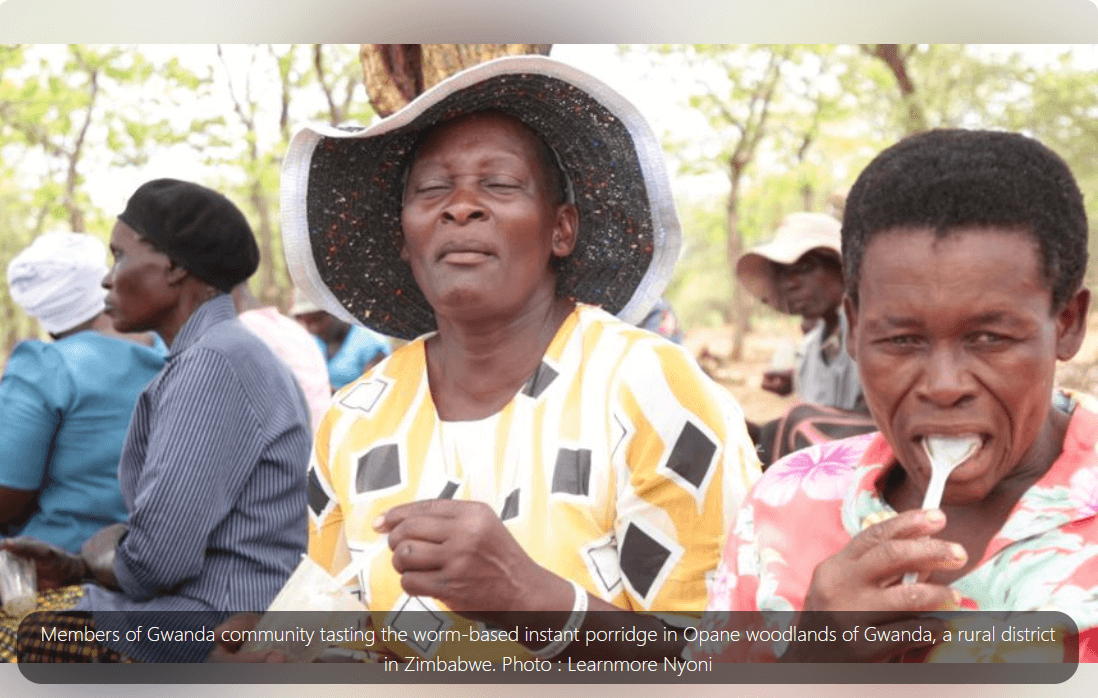As the wind blows through the Mopane woodlands of Gwanda, a rural district in Zimbabwe, Silibaziso Dube adjusts her waist wrapper and squats beside the fireplace to blow life to the dying flames where a large pot of water sits precariously on two rocks.
Members of the Gwanda community have gathered here to taste a new mopane worm-based instant porridge.
The mopane worm is an edible caterpillar commonly found in parts of Zimbabwe. It is consumed as a relish accompanied by thick, white maise porridge (sadza).
Studies show that mopane worms have up to 65% dry matter protein content and considerable quantities of essential minerals, such as zinc and iron. However, because of their texture, children cannot easily consume mopane worms directly.
“In the past, we could crush mopane worms and then mix them with millet porridges that we gave to our children,” says Dube.
The new instant porridge they are waiting to taste is a project led by the Insects4Nutrition research team.
Lesley Macheka, the project’s lead researcher, goes around the group, distributing disposable cups and spoons.
The previous year, Macheka’s research team purchased two tonnes of mopane worms in the area, injecting a vast cash supply to the community.
“We’ve returned to this community where we harvested the mopane worms, showing them the porridge and doing some sensory evaluations,” he said.
After a few minutes, Dube carefully pours the now-boiled water into each cup which contains the porridge powder.
“I think you should add more sugar for the porridge to appeal,” says Mponkiseng Sibanda after tasting it. Apart from that, there’s a consensus that the porridge is ‘very good’.
“The comments from the community were very positive; they liked the porridge,” said Macheka.
The novel mopane worm protein-enriched instant porridge, blended with either pearl millet or sorghum, modifies and enhances the traditional local insect porridge recipe.
“We are targeting solving micronutrient deficiency not only in children but also in adults. We are working on a mopane worm porridge because mopane worms have a very high protein content. Then combine this with pearl millet or sorghum, which also have very high levels of micronutrients, then you have a good product,” said Macheka.
The Insects4Nutrition project intends to integrate this new insect protein-enriched porridge into the school feeding programme, replacing the imported corn-soy blend porridges.
A quarter of children in Zimbabwean suffer from a malnourishment condition known as stunting, reports UNICEF Zimbabwe. The porridge targets children between the ages of seven and 11 who typically are in primary school.
Mopane worms trader, Saymore Ndlovu, told bird story agency that an individual can make up to $500 a year from mopane worm sales.
Community members are now meeting regularly to learn more about mopane worms, their ecology, handling techniques, costing, sustainable harvesting, marketing and preservation of the mopane woodlands.
Gwanda Forestry officer, Felix Fortunes Matutu, said the income from mopane worm sales incentivises villagers to adopt sustainable forestry practices that ensure the effective management of woodlots.
Mopane worms are exported to Europe, Botswana, South Africa and the Democratic Republic of Congo.
Gwanda’s mopane worm harvesters said they are now looking forward to the rollout of the mopane worm-based porridge to promote better nutrition and improve household incomes – since mopane worms will be bought in bulk.
In December 2022, entomologists at the Insects4Nutrition project constructed greenhouses to ensure a consistent supply of the critical ingredient of their porridge.
Rudo Sithole and Gracian Bara from the University of Zimbabwe are the two local entomologists working on the semi-domestication of mopane worms.
“We are running tests to semi-domesticate the mopane moth. We want to break the diapause of this moth since it appears only two times a year. We want to ensure an all-year-round supply of the mopane moth to support the mass production of this nutritious mopane worm-enriched product,” said Sithole.
Right now, however, the project is focusing on trials to test the efficacy of its new insect-fueled porridge.
bird story agency
In Gwanda, Zimbabwe, locals gathered to taste a new instant porridge made from mopane worms, an edible caterpillar high in protein and essential minerals like iron and zinc. The Insects4Nutrition research team developed this porridge, aiming to tackle micronutrient deficiencies, particularly among children aged 7 to 11, by combining mopane worms with millet or sorghum. The team previously bought two tonnes of mopane worms, significantly boosting the local economy.
The mopane worm-based porridge is intended to replace imported porridges in school feeding programs. Community members are also learning sustainable harvesting practices to support continued production. The project includes efforts to semi-domesticate mopane worms to ensure a year-round supply. Initial trials have shown positive community feedback, with suggestions to improve taste by adding more sugar.
Gwanda harvesters anticipate that this initiative will enhance nutrition and household incomes as mopane worms will be bought in bulk. Mopane worms are currently exported to various countries, and the project aims to establish a consistent supply through the construction of greenhouses.






